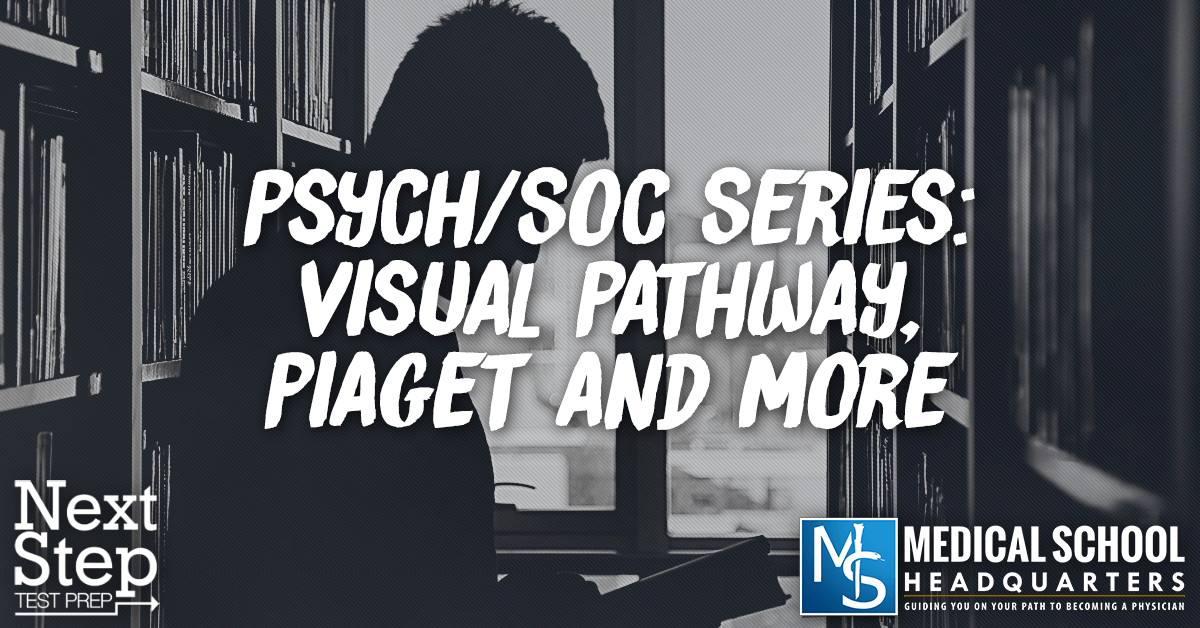Apple Podcasts | Google Podcasts

Session 85
Week two of our Psych/Soc MCAT series on the podcast and we’re covering more straight psych questions that you are going to need to know for the MCAT.
This podcast is a collaboration with Blueprint MCAT (formerly Next Step Test Prep). Today, Bryan joins me once again as we continue on this series. We will start more on the bio-based psychology questions until moving to the more classical psychology questions.
[01:20] Visual Pathway
Question 10: All of the following statements regarding the visual pathway are true, except:
- (A) The temporal fibers do not cross paths.
- (B) At least some of the optical fibers do cross paths.
- (C) At the optic chiasm, it is the nasal optic fibers that cross to opposite hemispheres.
- (D) Visual information does not travel through the parietal lobe.
Bryan’s Insights:
You can see where the trick is in this question. You could walk into the test having remembered that the occipital lobe is where all the visual information is processed. So if you’re reading a little fast and you see the word “not” and “parietal,” you may think it’s true. But the optic pads have to get to the occipital lobe and then traverse the parietal lobes as they get there. So the right answer here is D.
[03:20] Piaget’s Stages
Question: An 8-year-old child has recently developed the ability to understand the perspectives of her family members. According to Piaget, which stage has she entered?
- (A) Concrete operational
- (B) Formal operational
- (C) Pre-operational
- (D) Sensory motor
- Bryan’s Insights:
Answer choice D is out here since sensory motor is 0-2 years old where the kids are developing object permanence. They understand that what they see in the world stays there even when their eyes are shut.
Concrete operational stage is around 7-11 years old which is a pre-adolescent or school child age. Just the fact the child is 8 years old alone would tell you that it’s concrete operational.
Formal operational is from teenagers and up (12 years old and up) while preschool include the early toddlers.
Theoretically, MCAT could throw in awkward ages and this could come off as a trick. But Bryan clarifies that MCAT is not out to trick you. If they were going to give you an “unusual presentation in the clinic,” they would make it a point of calling it out. For example, they could ask something like: “Despite being 8 years old, the child is still unable to understand that other people have other perspectives.This tells us that the child is stuck in which of the following stages:” So as you can see, it will be real deliberate.
[06:35] Crystallized Intelligence
Question 2: Which of the following demonstrates the use of crystallized intelligence?
- (A) An 18-year old man visits France for the first time, buys a map at a local story, and uses it to navigate Paris.
- (B) A doctor sees a patient with a variety of strange symptoms. Using logic and deductive reasoning, he accurately diagnoses her with a very rare disease.
- (C) A toddler learns to walk after falling down during her first several attempts.
- (D) An experienced accountant fills out several financial statements over the course of an hour.
Bryan’s Insights:
What MCAT wants you to know here is fluid intelligence versus crystallized intelligence. Crystallized intelligence is something you’ve learned to do over a long period of time. And it’s applying your previously learned knowledge. So it’s not a new situation, not anything novel or weird. It’s something you’re really good at doing.
In this case, answer choice A talks about doing it “for the first time” so this tells you they’re in a weird, novel situation so they’re using their fluid intelligence to solve a new problem. A doctor (answer choice B) is the same way where he sees a strange symptom so he uses logic to diagnose a very rare disease. So the doctor is using their fluid intelligence to adapt to this novel situation and figure out what’s going on. Answer choice C, where a toddler learns how to walk and after falling down during her first several attempts, notice the word first there. So it’s still like the first time. Hence, answer choices A, B, and C are all fluid intelligence. It’s being flexible to it. It’s a new kind of learning.
Answer choice D mentions “experienced” so this is someone who has done this a million times before. They are highly intelligent at it and they have this rigid intelligence to fill out these financial statements. There is nothing novel here nor does it require any kind of fluidity or flexibility. It’s just applying already learned knowledge to these forms.
[11:05] Blueprint MCAT (formerly Next Step Test Prep)
Blueprint MCAT (formerly Next Step Test Prep) offers a full-length course. Check out my full review of that course on YouTube. Th course features over 100 hours of videos, ten lives office hours every week where you can actually ask questions to a tutor, their ten full-length exams, all the AAMC materials, and so much more. Plus, save some money on the course by using the promo code MCATPOD.
Links:
Blueprint MCAT (formerly Next Step Test Prep)
Blueprint MCAT (formerly Next Step Test Prep) review on YouTube
SEARCH SITE
SEARCH SITE
LISTEN FOR FREE











